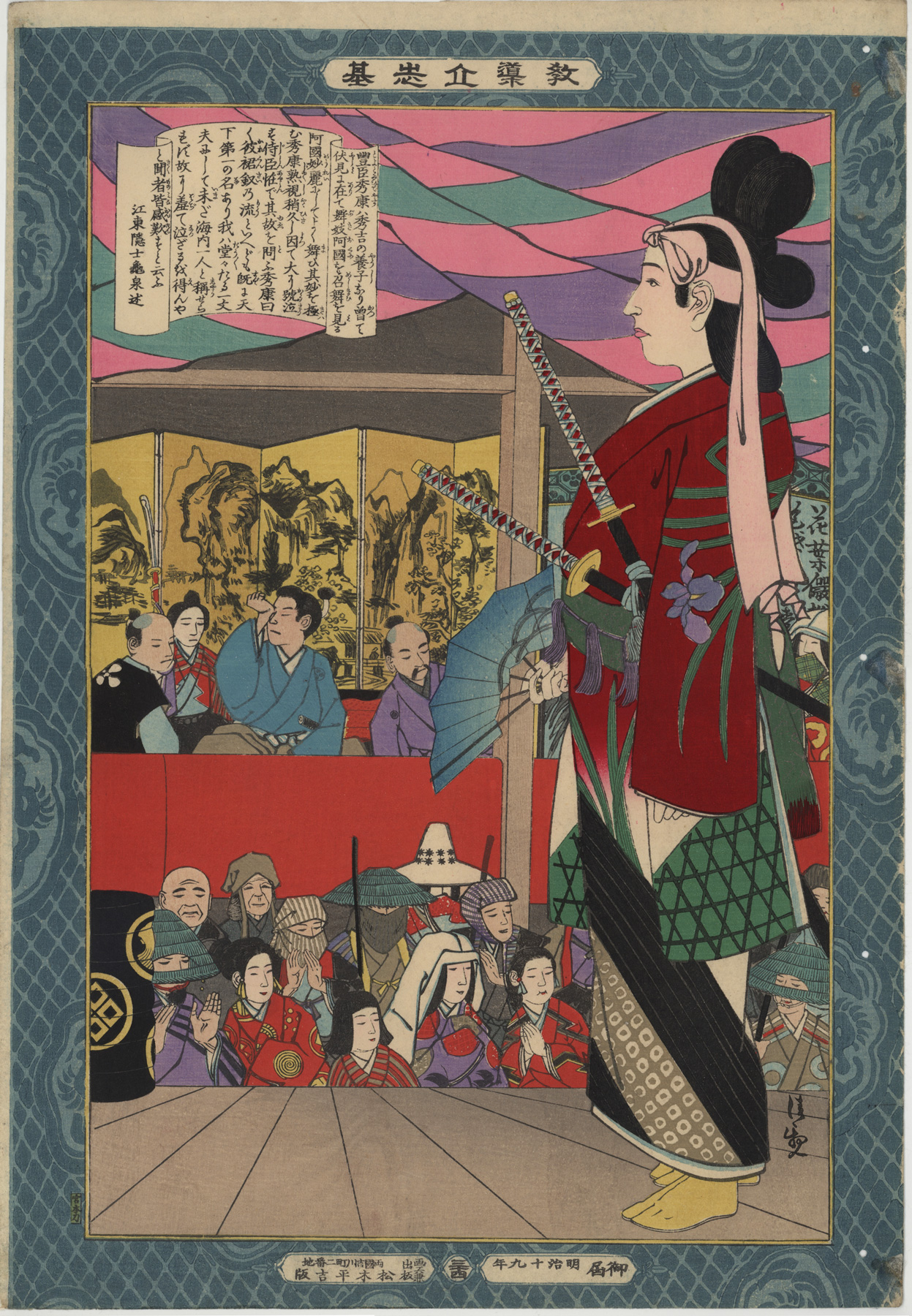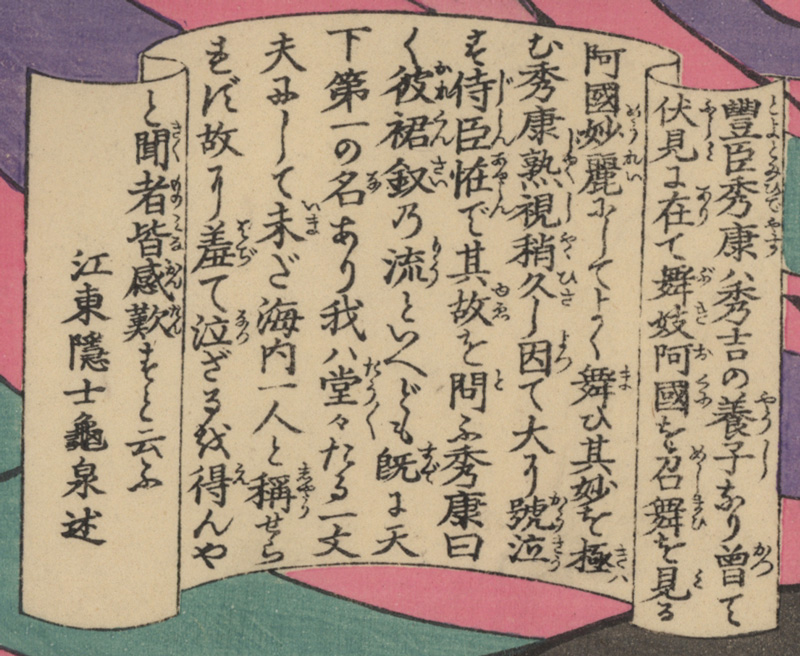About This Print
Print number 三十四 (34)1 in the series Instructive Models of Lofty Ambition picturing Toyotomi Hideyasu織田信長 (1574-1607), (adopted son of Toyotomi Hideyoshi), shedding tears at the performance of the dancer Okuni 阿国 in Fushimi 伏見 Castle. While there is historical evidence (see The Story of Okuni below) for Okuni's performance at Fushimi, whether Hideyasu was actually moved to tears is unknown.
Title of this Print in Table of Contents for this Series
1 Numbering of the prints was haphazard during the production of the series. Print numbers were sometimes inadvertently omitted; some prints in the series were never assigned numbers and a few of the same numbers appear on different prints.
2 Kiyochika Artist of Meiji Japan, Henry D. Smith II, Santa Barbara Museum of Art, 1988, p. 74.
This series ran between October 1885 and November 1890 and featured a long list of heroes and heroines, from antiquity to contemporary times, who were regarded as standards of moral leadership and self-realization.
Brief texts contained within a scroll-like cartouche appearing on each print provide historical details. The scroll composer's name is given at the end of the scroll text. The “lofty ambition” of the title is a Confucian concept, originally from Mencius, meaning “righteous determination that would inspire others.” The market for the series probably included former samurai, ambitious youth, and conservative intellectuals.
"[W]hen it was completed in 1890 the publisher was singled out for special recognition by the government for having sponsored such noble subject matter."3
1 The Tokyo Metropolitan Library online collection shows 50 prints and a Table of Contents sheet. The Table of Contents lists the titles of 50 prints. Smith in Kiyochika Artist of Meiji Japan identified 52 prints. I have identified 58 prints from this series including five prints (Ikina, Michizane Sugiwara, Kesa Gozen, Soga Brothers and Hokiichi Hanawa) that were re-designed and re-printed, likely due to damaged or lost blocks.
2 Robert Schaap notes in Appendix II, p. 166 of Yoshitoshi, Masterpieces from the Ed Freis Collection, Chris Uhlenbeck and Amy Reigle Newland, Hotei Publishing, 2011 that the series originally appeared as newspaper supplements.
3 The World of the Meiji Print: Impressions of a New Civilization, Julia Meech-Pekarik, Weatherhill, 1986, p. 122.
Kiyochika contributed 20 prints to this series. As Smith states: "The style of Kiyochika’s offerings to Instructive Models of Lofty Ambition was decorous and even stiff, as befitted the didactic emphasis of the whole [series.]"2
The titles used in the Table of Contents page for this series are taken from the scrolls on the prints and usually appear in the first column of the scroll. (See Table of Contents from the series Instructive Models of Lofty Ambition). For this print the Table of Contents lists the title as 越前少将 Echizen Shōshō (1595-1650), the son of Hideyasu, but nowhere in the scroll (see below) does Echizen's name appear.
1 Numbering of the prints was haphazard during the production of the series. Print numbers were sometimes inadvertently omitted; some prints in the series were never assigned numbers and a few of the same numbers appear on different prints.
2 Kiyochika Artist of Meiji Japan, Henry D. Smith II, Santa Barbara Museum of Art, 1988, p. 74.
The Story of Okuni
Source: "Kabuki Dancer," Sawako Ariyoshi, translated and introduced by James R. Brandon, from Asian Theatre Journal, Vol. 11, No. 2 (Autumn, 1994), p. 290-305, University of Hawaii Press
Okuni may or may not have been a priestess-dancer, a miko, of the Grand Shrine in Izumo. That part of her life remains a legend, but late sixteenth and early seventeenth-century historical accounts provide firm evidence that a woman named "Okuni from Izumo" lived and that she almost single-handedly founded kabuki theatre. Okuni's dances and scenes of town life were the first to be named "kabuki." Nearly four centuries later, the comic-erotic flavor of Okuni's performance continues to resonate in the sophisticated kabuki that we see on the stage today.
Like performers in many cultures, Okuni and the dancers, actors, and musicians in her troupe were despised. They were "riverbed beggars. " At the same time, Okuni was admired and famous among the ruling elite. Diaries of government officials describe Okuni giving command performances for Emperor Goyozei in Kyoto, for Hideyasu, son of the first Tokugawa shogun, Ieyasu, in Fushimi Castle in Kyoto, and in Edo (Tokyo) Castle for the second Tokugawa shogun, Hidetada, among others. As an artist Okuni could cross traditional gender and class divisions to give us a commoner's view of an exceptionally colorful and turbulent era of Japanese history. In the novel, Okuni's life and art intersect with Toyotomi Hideyoshi's megalomaniacal invasion of Korea and China, the slaughter of defeated generals after the Battle of Sekigahara, the founding of the city of Edo by shogun Tokugawa Ieyasu, and the expulsion of the Kirishitan (Christian) religion.
Transcription of Scroll
A scroll, present on each print in the series, contains brief historical details of the figure and scene being portrayed.
click on image to enlarge
Source: with thanks to Yajifun http://yajifun.tumblr.com/
34 ToyotomiHideyasu (Yūki Hideyasu)三十四
教導立志基 三十四 越前少将 小林清親 1886年
Transcription: [scroll text by 江東隠士龜泉]
“豊臣秀康ハ秀吉の養子なり 曾て伏見に在て舞妓阿國を召 舞を見る 阿國妙麗にしてよく舞ひ其妙を極む 秀康熟視稍久し因て大に號泣す 侍臣恠(あやしん)で其故を問ふ 秀康曰く 彼裙釵(くんさい)乃流といへども?(既)に天下第一の名あり 我ハ堂々たる一丈夫にして未だ海内一人と稱せられず 故に羞て泣ざるを得んや と 聞者皆感歎すと云ふ 江東隠士龜泉 述”
About The Series "Kyōdō risshi no motoi"
Notes:1. This series is variously translated as "Instructive Models of Lofty Ambition," "Foundations of Learning and Achievement," "Foundation of Instruction and Perseverance," "Self-Made Men Worthy of Emulation," "Paragons of Instruction and Success," "Moral of Success," "Examples of Self-Made Leaders," and "Instruction in the Fundamentals of Success." The title in Japanese is sometimes seen as "Kyōdō risshiki or "Kyōdō risshi no moto," in addition to the most commonly seen transliteration of "Kyōdō risshi no motoi".
2. For a complete listing of all the prints in the series and additional information please see the article on this site titled Instructive Models of Lofty Ambition.
This series ran between October 1885 and November 1890 and featured a long list of heroes and heroines, from antiquity to contemporary times, who were regarded as standards of moral leadership and self-realization.
Source: Kiyochika Artist of Meiji Japan, Henry D. Smith II, Santa Barbara Museum of Art, 1988, p. 74-75; original research and as footnoted.
This series of 58 prints,1 plus a table of contents sheet (目録), were originally published between October 1885 and November 1890 by the Tokyo publisher Matsuki Heikichi 松木平吉.2 The table of contents sheet issued by the publisher states that "fifty prints make up the complete set (五十番揃)". Three prints not in the initial release were added over the five year publication period, as were five redesigns of original prints, eventually increasing the total print count to 58. The seven artists contributing prints were Kobayashi Kiyochika (1847-1915) [20 prints], Mizuno Toshikata (1866-1908) [16 prints], Inoue Tankei (Yasuji) (1864-1889) [13 prints], Taiso (Tsukioka) Yoshitoshi (1839-1892) [5 prints], Yōshū Chikanobu (1838-1912) [2 prints], Toyohara Kunichika (1835–1900) [1 print], and Hachisuka (Utagawa) Kuniaki II (1835-1888) [1 print]. All the artists, with the exception of Yōshū Chikanobu, are listed in the top scroll of the table of contents sheet. Various colors (including blue, blue/green, and tan/brown) were used for the decorative border, and in 1902 the series was re-issued by Matsuki without borders.
This series of 58 prints,1 plus a table of contents sheet (目録), were originally published between October 1885 and November 1890 by the Tokyo publisher Matsuki Heikichi 松木平吉.2 The table of contents sheet issued by the publisher states that "fifty prints make up the complete set (五十番揃)". Three prints not in the initial release were added over the five year publication period, as were five redesigns of original prints, eventually increasing the total print count to 58. The seven artists contributing prints were Kobayashi Kiyochika (1847-1915) [20 prints], Mizuno Toshikata (1866-1908) [16 prints], Inoue Tankei (Yasuji) (1864-1889) [13 prints], Taiso (Tsukioka) Yoshitoshi (1839-1892) [5 prints], Yōshū Chikanobu (1838-1912) [2 prints], Toyohara Kunichika (1835–1900) [1 print], and Hachisuka (Utagawa) Kuniaki II (1835-1888) [1 print]. All the artists, with the exception of Yōshū Chikanobu, are listed in the top scroll of the table of contents sheet. Various colors (including blue, blue/green, and tan/brown) were used for the decorative border, and in 1902 the series was re-issued by Matsuki without borders.
Brief texts contained within a scroll-like cartouche appearing on each print provide historical details. The scroll composer's name is given at the end of the scroll text. The “lofty ambition” of the title is a Confucian concept, originally from Mencius, meaning “righteous determination that would inspire others.” The market for the series probably included former samurai, ambitious youth, and conservative intellectuals.
"[W]hen it was completed in 1890 the publisher was singled out for special recognition by the government for having sponsored such noble subject matter."3
1 The Tokyo Metropolitan Library online collection shows 50 prints and a Table of Contents sheet. The Table of Contents lists the titles of 50 prints. Smith in Kiyochika Artist of Meiji Japan identified 52 prints. I have identified 58 prints from this series including five prints (Ikina, Michizane Sugiwara, Kesa Gozen, Soga Brothers and Hokiichi Hanawa) that were re-designed and re-printed, likely due to damaged or lost blocks.
2 Robert Schaap notes in Appendix II, p. 166 of Yoshitoshi, Masterpieces from the Ed Freis Collection, Chris Uhlenbeck and Amy Reigle Newland, Hotei Publishing, 2011 that the series originally appeared as newspaper supplements.
3 The World of the Meiji Print: Impressions of a New Civilization, Julia Meech-Pekarik, Weatherhill, 1986, p. 122.
Print Details
| IHL Catalog | #1293 |
| Title or Description | Toyotomi Hideyasu 織田信長 |
| Series | “Instructive Models of Lofty Ambition” (Kyodo risshiki 教導立志基) [note: series title also listed as 'Kyodo Risshi no Moto', ‘Kyodo risshi no motoi’, ‘Kyōdō risshi ki’ and variously translated as “Moral of success” or “Foundations of learning and achievement” or “Self-made Men Worthy of Emulation”' or “Examples of Self-made Leaders” or "Paragons of instruction and success"] |
| Artist | Kiyochika Kobayashi (1847-1915) |
| Signature |  清親 Kiyochika 清親 Kiyochika |
| Seal | not sealed |
| Publication Date | 1886 明治十九年 Meiji 19 |
| Publisher | Matsuki Heikichi (松木平吉) proprietor of Daikokuya Heikichi [Marks: seal not shown; pub. ref. 029] click to enlarge (from right to left) publishing and printing date: 御届 明治 十九年 [notification delivered, Meiji 19] assigned number within series: 三十四 (34) publisher information: 画工兼 出板 両国吉川町二番地 松木平吉 版 [artist and publisher Ryōgoku Yoshikawachō 2-banchi Matsuki Heikichi han] |
| Carver |  宮本刀 Miyamoto tō 宮本刀 Miyamoto tō |
| Impression | excellent |
| Colors | excellent |
| Condition | good - full size; not backed; five small binding holes along right border; minor marks |
| Genre | ukiyo-e; rishki-e; kyōiku nishiki-e |
| Miscellaneous | print number 34 (三十四); position 34 in the Table of Contents for the series |
| Format | vertical oban |
| H x W Paper | 14 1/2 x 9 7/8 in. (36.8 x 25.1 cm) |
| H x W Image | 12 5/8 x 8 1/4 in. (32.1 x 21 cm) area inside brocade border |
| Literature | |
| Collections This Print | British Museum 1906,1220,0.1818; Tokyo Metropolitan Library 280-K026 (with tan-colored border); The Tsubouchi Memorial Theatre Museum of Waseda University 201-0616; Edo-Tokyo Museum 96200395 |



